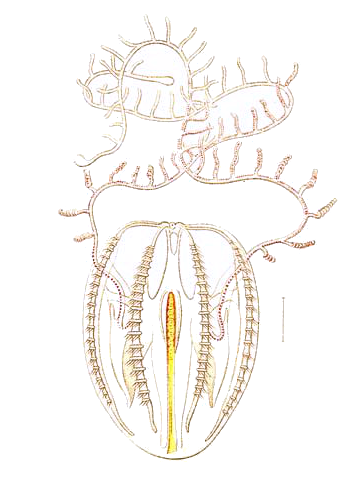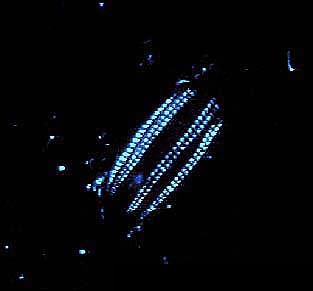|
Cydippida
Cydippida is an order of comb jellies. They are distinguished from other comb jellies by their spherical or oval bodies, and the fact their tentacles are branched, and can be retracted into pouches on either side of the pharynx. The order is not monophyletic, that is, more than one common ancestor is believed to exist. Anatomy Cydippids have bodies that are more or less rounded, sometimes nearly spherical and other times more cylindrical or egg-shaped; the common coastal "sea gooseberry," ''Pleurobrachia'', has an egg-shaped body with the mouth at the narrow end. From opposite sides of the body extends a pair of long, slender tentacles, each housed in a sheath into which it can be withdrawn. Some species of cydippids have bodies that are flattened to various extents, so that they are wider in the plane of the tentacles. The tentacles are typically fringed with tentilla ("little tentacles"), although a few genera have simple tentacles without these side-branches. The tentacles and ... [...More Info...] [...Related Items...] OR: [Wikipedia] [Google] [Baidu] |
Comb Jelly
Ctenophora (; ctenophore ; ) comprise a phylum of marine invertebrates, commonly known as comb jellies, that inhabit sea waters worldwide. They are notable for the groups of cilia they use for swimming (commonly referred to as "combs"), and they are the largest animals to swim with the help of cilia. Depending on the species, adult ctenophores range from a few millimeters to in size. Only 100 to 150 species have been validated, and possibly another 25 have not been fully described and named. The textbook examples are cydippids with egg-shaped bodies and a pair of retractable tentacles fringed with tentilla ("little tentacles") that are covered with colloblasts, sticky cells that capture prey. Their bodies consist of a mass of jelly, with a layer two cells thick on the outside, and another lining the internal cavity. The phylum has a wide range of body forms, including the egg-shaped cydippids with retractable tentacles that capture prey, the flat generally combless plat ... [...More Info...] [...Related Items...] OR: [Wikipedia] [Google] [Baidu] |
Euplokamididae
''Euplokamis'' is a genus of ctenophores, or comb jellies, belonging to the monotypic family Euplokamididae. Despite living for hundreds of millions of years in marine environments, there is minimal research regarding ''Euplokamis'', primarily due to their body structure. Research on the evolution of the basic body structures of diploblastic metazoans revealed that there are four major phyla, including the Ctenophores. Although the morphology of ''Euplokamis'' often resembles the medusa stage of Cnidarians, their eight rows of combs are one distinguishing feature that led to the official classification of Ctenophores. After being originally described by Chun (1879), the family '' Euplokamididae'' was expanded by Mills (1987) due to the discovery of a new species, ''Euplokamis dunlapae''. Further research indicated that ''Euplokamis'' should be identified from Mertensiidae due to the rows of combs and some compression. They may also be distinguished from the genus ''Pleurobrachi ... [...More Info...] [...Related Items...] OR: [Wikipedia] [Google] [Baidu] |
Euplokamis
''Euplokamis'' is a genus of ctenophores, or comb jellies, belonging to the monotypic family Euplokamididae. Despite living for hundreds of millions of years in marine environments, there is minimal research regarding ''Euplokamis'', primarily due to their body structure. Research on the evolution of the basic body structures of diploblastic metazoans revealed that there are four major phyla, including the Ctenophores. Although the morphology of ''Euplokamis'' often resembles the medusa stage of Cnidarians, their eight rows of combs are one distinguishing feature that led to the official classification of Ctenophores. After being originally described by Chun (1879), the family ''Euplokamididae'' was expanded by Mills (1987) due to the discovery of a new species, ''Euplokamis dunlapae''. Further research indicated that ''Euplokamis'' should be identified from Mertensiidae due to the rows of combs and some compression. They may also be distinguished from the genus ''Pleurobrachia'' d ... [...More Info...] [...Related Items...] OR: [Wikipedia] [Google] [Baidu] |
Duobrachium Sparksae
''Duobrachium'' is a monotypic genus of comb jellies belonging to the order Cydippida, family unknown. The only species is ''Duobrachium sparksae''. Discovery It was discovered and identified based only on video footage of three specimens after being observed by the Deep Discoverer robotic vehicle, operated by the US National Oceanic and Atmospheric Administration The National Oceanic and Atmospheric Administration (abbreviated as NOAA ) is an United States scientific and regulatory agency within the United States Department of Commerce that forecasts weather, monitors oceanic and atmospheric conditi .... It was first discovered in a canyon at a depth of to the north west of the Puerto Rican coast in April 2015. Physical characteristics The animal has a rectangular shape when viewed in the tentacular plane, but oval from the perpendicular plane. It has two long tentacle arms which protrude from the centre of the sides of the body, and extend downwards. These are about ... [...More Info...] [...Related Items...] OR: [Wikipedia] [Google] [Baidu] |
Bathyctenidae
Bathyctenidae is a family of ctenophores belonging to the order Cydippida Cydippida is an order of comb jellies. They are distinguished from other comb jellies by their spherical or oval bodies, and the fact their tentacles are branched, and can be retracted into pouches on either side of the pharynx. The order is not .... The family consists of only one genus: ''Bathyctena'' Mortensen, 1932. References Tentaculata {{ctenophore-stub ... [...More Info...] [...Related Items...] OR: [Wikipedia] [Google] [Baidu] |
Cryptocodidae
Cryptocodidae is a family of ctenophores belonging to the order Cydippida Cydippida is an order of comb jellies. They are distinguished from other comb jellies by their spherical or oval bodies, and the fact their tentacles are branched, and can be retracted into pouches on either side of the pharynx. The order is not .... The family consists of only one genus: ''Cryptocoda'' Leloup, 1938. References Tentaculata Monogeneric animal families {{ctenophore-stub ... [...More Info...] [...Related Items...] OR: [Wikipedia] [Google] [Baidu] |
Ctenellidae
Ctenellidae is a family of ctenophores Ctenophora (; ctenophore ; ) comprise a phylum of marine invertebrates, commonly known as comb jellies, that inhabit sea waters worldwide. They are notable for the groups of cilia they use for swimming (commonly referred to as "combs"), and ... belonging to the order Cydippida. The family consists of only one genus: ''Ctenella'' Carré & Carré, 1993. References Tentaculata {{ctenophore-stub ... [...More Info...] [...Related Items...] OR: [Wikipedia] [Google] [Baidu] |
Dryodoridae
Dryodoridae is a family of ctenophores belonging to the order Cydippida Cydippida is an order of comb jellies. They are distinguished from other comb jellies by their spherical or oval bodies, and the fact their tentacles are branched, and can be retracted into pouches on either side of the pharynx. The order is not .... The family consists of only one genus: ''Dryodora'' Agassiz, 1860. References Tentaculata {{ctenophore-stub ... [...More Info...] [...Related Items...] OR: [Wikipedia] [Google] [Baidu] |
Tentaculata
Tentaculata is a class of comb jellies. The common feature of this class is a pair of long, feathery, contractile tentacles, which can be retracted into specialised ciliated sheaths. In some species, the primary tentacles are reduced and they have smaller, secondary tentacles. The tentacles have colloblasts, which are sticky-tipped cells that trap small prey. Body size and shape varies widely. The group includes the small, oval sea gooseberries found on both Atlantic and Pacific coasts. The more flattened species of the genus '' Mnemiopsis'', about long, are common on the upper Atlantic coast; it has a large mouth and mainly feeds on larval molluscs and copepods. This species is brilliantly luminescent. The similar, but larger, genus '' Leucothea'' is abundant on the Pacific coast. Venus girdle The Venus girdle (''Cestum veneris'') is a comb jelly in the family Cestidae. It is the only member of its genus, ''Cestum''. Description Venus girdles resemble transparent ri ... [...More Info...] [...Related Items...] OR: [Wikipedia] [Google] [Baidu] |
Haeckelia
''Haeckelia'' is a genus of ctenophore Ctenophora (; ctenophore ; ) comprise a phylum of marine invertebrates, commonly known as comb jellies, that inhabit sea waters worldwide. They are notable for the groups of cilia they use for swimming (commonly referred to as "combs"), and ...s belonging to the family Cydippida. The species of this genus are found in Europe and Northern America. Species: *'' Haeckelia beehleri'' *'' Haeckelia bimaculata'' *'' Haeckelia filigera'' *'' Haeckelia rubra'' References Tentaculata {{ctenophore-stub ... [...More Info...] [...Related Items...] OR: [Wikipedia] [Google] [Baidu] |
Lampeidae
Lampeidae is a family of ctenophores belonging to the order Cydippida. Genera: * '' Gastropodes'' * ''Lampea'' Stechow, 1921 * ''Lampetia In Greek mythology, Lampetia ( grc, Λαμπετίη, translit=Lampetíē or grc, Λαμπετία, label=none, translit=Lampetía, lit=shining) was the daughter of Helios and Neaera; she was the personification of light. Her twin sister, Pha ...'' Chun, 1880 References Tentaculata Animal families {{ctenophore-stub ... [...More Info...] [...Related Items...] OR: [Wikipedia] [Google] [Baidu] |
Mertensiidae
Mertensiidae is a family of ctenophores belonging to the order Cydippida. Genera: * '' Callianira'' Péron & Lesueur, 1808 * '' Charistephane'' Chun, 1879 * ''Gastrodes'' Korotneff, 1888 * ''Mertensia ''Mertensia'' is a genus of flowering plants in the family Boraginaceae. They are perennial herbaceous plants with blue or sometimes white flowers that open from pink-tinged buds. Such a change in flower color is common in Boraginaceae and ...'' Lesson, 1830 References Tentaculata {{ctenophore-stub ... [...More Info...] [...Related Items...] OR: [Wikipedia] [Google] [Baidu] |


